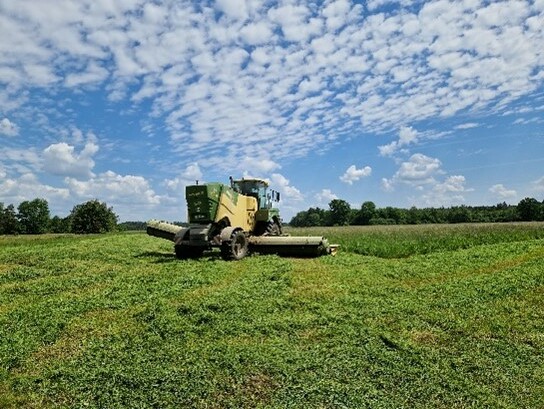What was the challenge/ problem addressed?
The decline in cattle farming in Bavaria requires alternative uses for the management of grassland in agriculture. Many grassland areas are only managed due to the incentive of high area premiums. On the other hand, there is a shortage of high-quality protein feed, which leads to high import. The larva of Hermetia lllucens can be a piece of the puzzle here and convert grassland fodder of limited use into needed high-quality protein fodder. The project aims to develop a concept for a reasonable alternative use in grassland cultivation to achieve added value for agriculture. Active management of unused grassland can generate diversification for agricultural businesses.
In combination with other forms of animal farming, such as poultry fattening, it can offer added value for farms in agricultural privileged approval. For example, grassland areas could also be counted in the calculation of the feed base by producing the grass as feed for the insects and feeding the poultry with the insects.
How did you solve the problem?
The problems will be solved by analysing and designing the necessary adaptations as well as optimisations of the complete process chain of grassland management, from cultivation and harvesting technology to storage (silage) and automated feeding into insect fattening. The aim is the preparation of a concept for the development of the optimal suitable plant technology for processing and automated feeding. In addition, a concept will be developed to determine which feed mixed with grass silage best meets the requirements of Hermitia lllucens larvae. An initial test to see whether the insect larvae can utilize grass silage at all was very promising.
The concept for optimizing the process chain, developing an automated processing, and conveying technology can be developed and integrated into the insect farm at the Söltl Landwirtschafts GbR farm, which is operated by Agritech Solutions GmbH.
What is innovative in your practical case?
Currently there are no farms that use grassland for insect fattening on a practical scale. Experience values on the requirements within the individual process steps for the management of grassland are therefore not known. The creation of a concept is therefore a first step towards transferring this innovation into practice.
What are the success factors in solving the problem?
The concept for using grassland for insect fattening lowers the entry hurdle in terms of effort, know-how and costs compared to arable farming. However, this can also result in additional sales potential independently of the implementation of an insect fattening system if such a system can be supplied with grass.
Unexpected fails, if any
The technical properties were formulated in a misleading way at the beginning and the technical design was accordingly incorrect,it was later corrected.
Lessons learned
We have learned that the requirements must be precisely defined and communicated in order to achieve a common project goal.
Networking of stakeholders from a wide variety of areas was very important so as to be able to optimally develop the full range of topics that are involved in the project.
Team building is very key in this project as it enables project actors to work together in a foresighted manner with the focus of achieving the project goals.
Frequent communication and consultation is important to keep actors moving and motivated ,longing to find out what comes next and the interaction between actors in bringing new ideas and airing their views has also been realised as an important drive towards meeting project goals.
Proper organisation and allocation of roles to various actors before the project starts and difining clearly the main aim of the project to actors is important to ensure a smooth run of the project without a lot inconveniences.
What role does the advisor or advisory service play within the practical case
For the concept phase, we had a consultant who is an expert in the field of insect fattening. We worked together to gain experience in relation to our problem.
Can your approach be transferred and/or adapted for other innovation challenges and regions?
Yes.
For sharing the experience on the good practice, please contact Tobias Söltl (email: tobias.soeltl@agritech-solutions.de)




